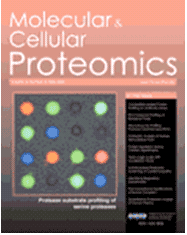Proteomics
 In collaboration with the Ellman laboratory (UC Berkeley), we have profiled substrate preferences for a number of proteases. Proteases regulate numerous biological processes with a degree of specificity often dictated by the amino acid sequence of the substrate cleavage site. To map protease/substrate interactions, a 722-member library of fluorogenic protease substrates of the general format Ac-Ala-X-X-(Arg/Lys)-coumarin was synthesized (X = all natural amino acids except cysteine) and microarrayed, along with fluorescent calibration standards, in glycerol nanodroplets on glass slides. Specificities of 13 serine proteases (activated protein C, plasma kallikrein, factor VIIa, factor IXa b , factor XIa and factor a XIIa, activated complement C1s, C1r and D, tryptase, trypsin, subtilisin Carlsberg and cathepsin G) and 11 papain-like cysteine proteases (cathepsin B, H, K, L, S and V, rhodesain, papain, chymopapain, ficin and stem bromelain) were obtained from 103,968 separate microarray fluorogenic reactions (722 substrates x 24 different proteases x 6 replicates). This is the first comprehensive study to report the substrate specificity of rhodesain, a papain-like cysteine protease expressed by Trypanasoma brucei rhodesiense, a parasitic protozoa responsible for causing sleeping sickness. Rhodesain displayed a strong P 2 preference for Leu, Val, Phe, Tyr in both the P 1 = Lys and Arg libraries. Solution phase microarrays facilitate protease/substrate specificity profiling in a rapid manner with minimal peptide library or enzyme usage. In collaboration with the Ellman laboratory (UC Berkeley), we have profiled substrate preferences for a number of proteases. Proteases regulate numerous biological processes with a degree of specificity often dictated by the amino acid sequence of the substrate cleavage site. To map protease/substrate interactions, a 722-member library of fluorogenic protease substrates of the general format Ac-Ala-X-X-(Arg/Lys)-coumarin was synthesized (X = all natural amino acids except cysteine) and microarrayed, along with fluorescent calibration standards, in glycerol nanodroplets on glass slides. Specificities of 13 serine proteases (activated protein C, plasma kallikrein, factor VIIa, factor IXa b , factor XIa and factor a XIIa, activated complement C1s, C1r and D, tryptase, trypsin, subtilisin Carlsberg and cathepsin G) and 11 papain-like cysteine proteases (cathepsin B, H, K, L, S and V, rhodesain, papain, chymopapain, ficin and stem bromelain) were obtained from 103,968 separate microarray fluorogenic reactions (722 substrates x 24 different proteases x 6 replicates). This is the first comprehensive study to report the substrate specificity of rhodesain, a papain-like cysteine protease expressed by Trypanasoma brucei rhodesiense, a parasitic protozoa responsible for causing sleeping sickness. Rhodesain displayed a strong P 2 preference for Leu, Val, Phe, Tyr in both the P 1 = Lys and Arg libraries. Solution phase microarrays facilitate protease/substrate specificity profiling in a rapid manner with minimal peptide library or enzyme usage.
Publications
| 1. |
2005 |
Gosalia DN, Salisbury CM, Ellman JA, Diamond SL. High throughput substrate specificity profiling of serine and cysteine proteases using solution-phase fluorogenic peptide microarrays. Mol Cell Proteomics 2005; 4 (5): 626-636  |
| 2. |
|
Gosalia DN, Salisbury CM, Maly DJ, Ellman JA, Diamond SL. Profiling serine protease substrate specificity with solution phase fluorogenic peptide microarrays. Proteomics 2005; 5 (5): 1292-1298  |
| 3. |
2006 |
Gosalia DN, Denney WS, Salisbury CM, Ellman JA, Diamond SL. Functional phenotyping of human plasma using a 361-fluorogenic substrate biosensing microarray. Biotechnol Bioeng 2006; :  |
| 4. |
2007 |
Diamond SL. Methods for mapping protease specificity. Curr Opin Chem Biol 2007; 11 (1): 46-51  |
| 5. |
2008 |
Beavers MP, Myers MC, Shah PP, Purvis JE, Diamond SL, Cooperman BS, Huryn DM, Smith AB, 3rd. Molecular docking of cathepsin L inhibitors in the binding site of papain. J Chem Inf Model 2008; 48 (7): 1464-1472  |
| 6. |
|
Diamond SL, Greenbaum D. Proteases' prime targets revealed. Nat Biotechnol 2008; 26 (6): 652-653  |
|





